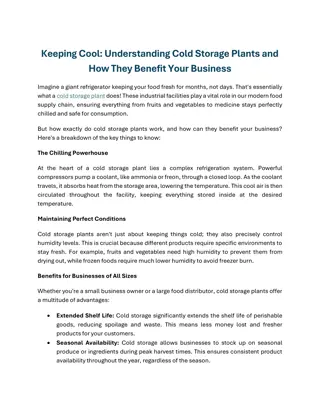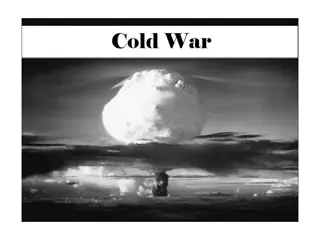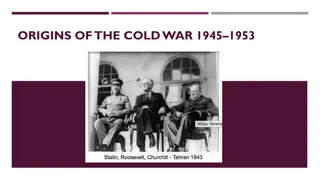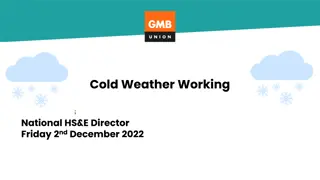
Cold Safety: Risks, Symptoms & First Aid Tips
Learn about the dangers of cold exposure, including cold shock, hypothermia, and frostbite. Discover the symptoms to watch out for and essential first aid tips to help someone suffering from cold-related conditions.
Download Presentation

Please find below an Image/Link to download the presentation.
The content on the website is provided AS IS for your information and personal use only. It may not be sold, licensed, or shared on other websites without obtaining consent from the author. If you encounter any issues during the download, it is possible that the publisher has removed the file from their server.
You are allowed to download the files provided on this website for personal or commercial use, subject to the condition that they are used lawfully. All files are the property of their respective owners.
The content on the website is provided AS IS for your information and personal use only. It may not be sold, licensed, or shared on other websites without obtaining consent from the author.
E N D
Presentation Transcript
What Can Happen? ? Sudden exposure to cold may cause cold shock ? Prolonged exposure to cold can lead to several things ? Frostbite ? Hypothermia
Cold Shock ? Cold shock is caused by the sudden lowering of skin temperature, usually from immersion in cold water and may cause one or more of the following ? Loss of Breathing Control- Such as gasping (gasping underwater may lead to drowning), hyperventilation (very rapid, out of control breathing) ? Heart/Blood Pressure Problems- Cold water immersion causes an instant increase in heart rate and blood pressure since all the blood vessels in your skin constrict in response to sudden cooling. ? Mental Problems- Cold shock causes a reduction in the ability to think and function
Human Body Temperatures ? Normal body temperature is 98.6 0F ? Shivering and sensation of cold can begin at approximately 96.5 0F ? Amnesia can begin to set in at approximately 94 0F ? Unconsciousness at approximately 86 0F ? Death can occur at approximately 79 0F
Hypothermia ? Caused by prolonged exposure to very cold temperatures ? Your body loses heat faster than it s produced ? Low temperatures affect the brain, making it hard to think clearly ? Can occur even at cool temperatures if a person is chilled from rain, sweat, or immersion in cold water
Hypothermia Cont. ? If you see these symptoms, take action! Don t wait ? Get the person into a warmer place ? Remove any wet clothing ? Wrap in a warm blanket ? Give warm drinks, NO ALCOHOL! ? Get medical attention as soon as possible ? Adults symptoms include shivering, exhaustion, confusion, fumbling hands, slurred speech, drowsiness ? Baby symptoms include bright red, cold skin and very low energy
Frostbite ? Frostbite is an injury caused by freezing. It leads to loss of feeling and color in the areas it affects, usually extremities such as the nose, ears, cheeks, chin fingers and toes. Frostbite can permanently damage the body, severe cases can lead to amputation
Frostbite Cont. ? If you see these symptoms, take action! Don t wait ? Get the person to a warm space ? DO NOT rub the frostbitten area, you may cause more damage ? Put affected areas in warm, NOT HOT, water ? DO NOT use a heating pad, or lamp, or stove etc., affected areas can easily burn ? GET MEDICAL CARE IMMEDIATELY! ? People with poor circulation and those not properly dressed for cold weather are more at risk ? Symptoms include white or grayish-yellow skin, skin that feels unusually firm or waxy and numbness
Wind Chill ? If the temperature is 38 F and the wind chill is 32 F, that means you'd develop frostbite on exposed skin just as quickly as you would if the temperature was 32 F and there was no wind ? So wind chill should be taken into account when determining what clothing to wear/bring, how long to stay outside, etc.
Outdoor Preparation Watch for signs of hypothermia and frostbite Wear layered clothing, mittens or gloves, and a hat and proper footwear. Outer layer should be water resistant ? ? Make sure someone knows where you are going and when you are expected to return ? Cover your mouth to protect your lungs from freezing air ? Bring along food and water, avoid alcoholic and caffeinated beverages ? Keep dry, change wet clothing frequently, wet clothing loses its insulating properties ? Avoid overexertion, such as shoveling heavy snow, pushing a vehicle, or walking in deep snow. The strain from the cold and the hard labor may cause a heart attack. Sweating could lead to a chill and hypothermia. ? Avoid walking on ice when possible ? Have means of communication and fire starting with you ?
Indoor Preparation Be prepared for power outages, extra blankets, winter clothes, sleeping bags ? Have a safe alternate means of supplying heat ? Be aware of the risk of carbon monoxide poisoning with heating systems ? Have a water supply, if a storm is imminent fill the tub for example ?
Car Preparation ? Flashlight ? Bag of cat litter (or sand/salt) ? Snow shovel ? First aid kit ? Ice scraper ? Jumper cables ? Water
Car Prep Cont. ? Blanket ? Cell phone charger ? Reflective triangles ? Non-perishable snacks ? Toolkit ? Winter clothes/boots ? Other items including-empty gas can, tow strap, fire extinguisher, duct tape, emergency contact sheet
Conclusion ? Cold related issues can be anything from mild to life threatening ? Be aware of potential issues ? Proper preparation can go a long way to prevent adverse outcomes






















